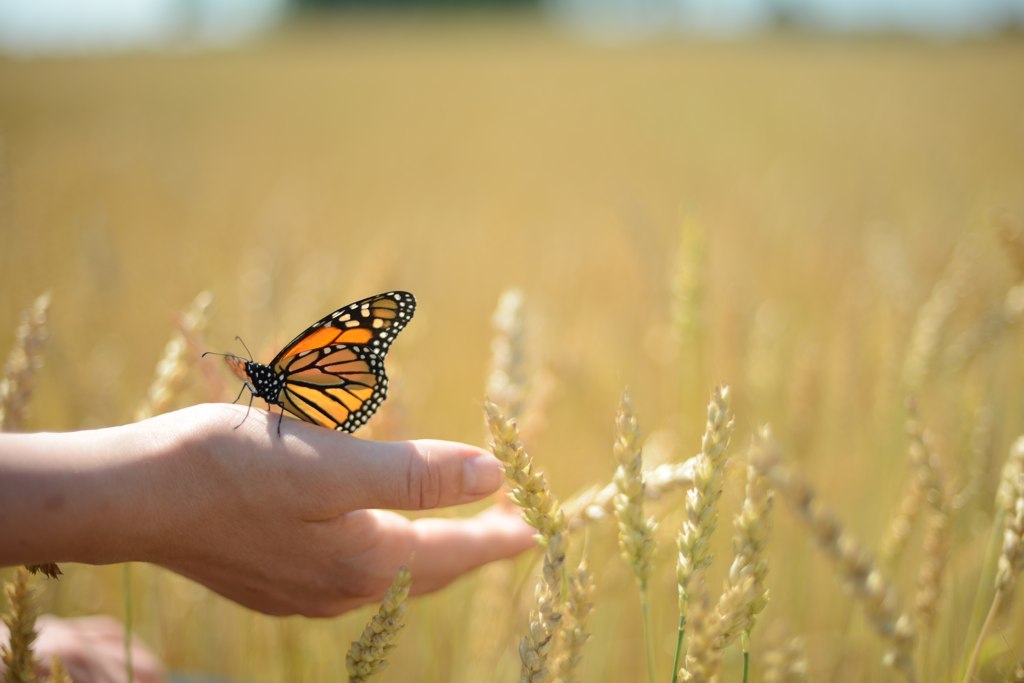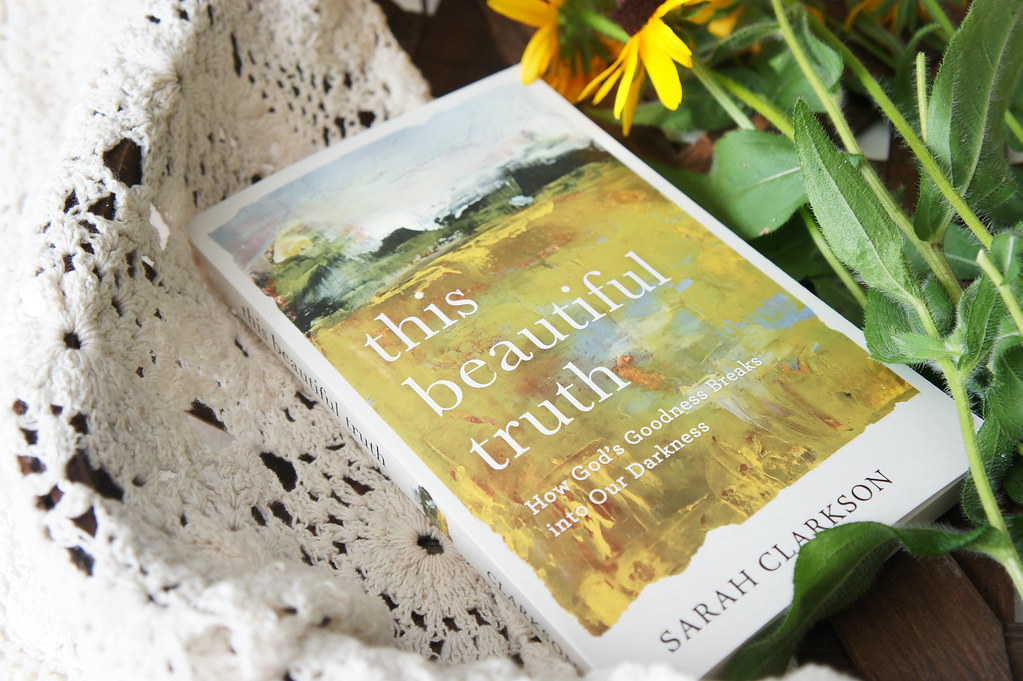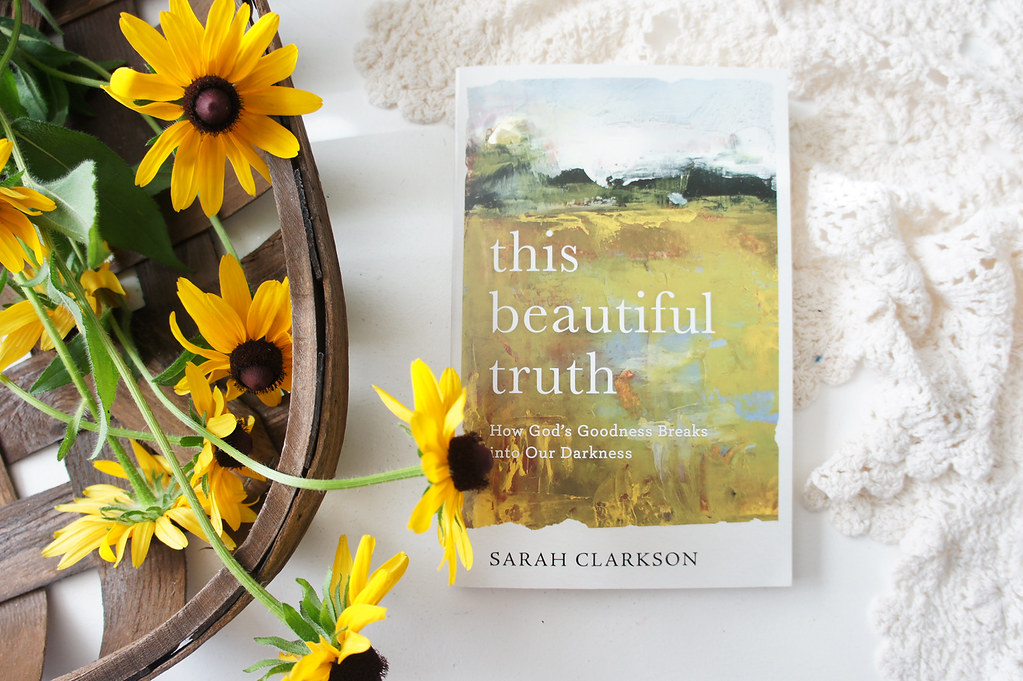Sarah Clarkson is a writer who loves books, beauty, and imagination, and wants to offer those as hope to a broken world. Having wrestled with mental illness and impossible questions for decades, her passion is to help her readers discover the healing power of God’s beauty as it reaches out to them in the very heart of their suffering. She’s been writing about story and beauty for a decade, and in her latest book she explores the profound healing she’s found in the ‘taste and see goodness’ of a beautiful God. It’s a grace to welcome Sarah to the farm’s front porch today…
The summer of my ninth year, I had butterfly mania.
Early one morning I discovered a dewy-winged marvel of a creature in my grandmother’s garden, all midnight black and iridescent blue with circles of white that glimmered up at me like eyes. “Oh, it’s a swallowtail,” said my grandmother when I showed her.
“I still find it hard to write about the obsessive, intrusive images that have plagued me throughout my life.”
She gave me an old Audobon guide, and it became my obsessive study as the names, the rare, gleaming colors of the butterflies opened an otherworld of beauty that made me hungry for something I couldn’t name.
One day, I followed that hunger deep into the crackling heat of the summer fields in chase of a ‘buckeye’ butterfly. I ran until my breath gave out. I remember sinking to the dirt, knees knobbled by the pebbles, laughing after my fifth attempt to catch the little thing.
I was delighted in the hunt after that beauty, the way it flashed out, an unexpected grace in the brown landscape, the way it made me hungry and happy all at once. My breath slowed. The pounding of my blood eased in my ears and I sat back on my heels, alert and still.
Abruptly, and more completely than I can describe, my sense of time was suspended as I lifted my face to the great blue dome of the Texas sky, brimmed with the honey-tinged light of late afternoon.
The sounds of the earth grew distant, and a quiet came into my mind and body.
For one mesmerizing moment I became aware of the personal, present goodness thrumming in every atom of the world around me.
I knew that this was the beauty whose presence I yearned to touch in the mystical beauty of those butterfly wings.
I knew that I was encountering God. And I knew, with a knowledge as pervasive within me as my own heartbeat, that I was loved, loved, loved.
I felt as if the brown wings of the cosmos itself had fluttered open and what I glimpsed was the mesmerizing beauty of Love.
This, I knew in my bones, is my story.
Until a dark night, probably just a few weeks later though I cannot now exactly remember.











“I knew that I was encountering God. And I knew, with a knowledge as pervasive within me as my own heartbeat, that I was loved, loved, loved.”
I had been kissed and put to bed as usual by my parents. I lay in the darkness, waiting for the descent of sleep.
But my brain seemed strangely wired; my thoughts began to careen toward images of horror that terrified me. My heart beat faster. My imagination ran at frenzied speed, peopling the room I couldn’t now see with evil shapes as my imagination flung scene after scene into my mind, images that baffle and disgust me to this day.
I still find it hard to write about the obsessive, intrusive images that have plagued me throughout my life.
I tried to describe them to my mom when I was young, but even then I was too ashamed to give full description to the violent, perverted ideas and pictures that came from out of some void inside my own brain, wrapping themselves around my inner pictures of the people I loved most in the world.
“I think this is the fight to which each of us is called every day of our lives as we question where God dwells in the midst of our deepest pain.“
I felt attacked and guilty, terrified and contaminated.
It would be eight more years before I was diagnosed with a lesser-known form of OCD when hormones and stress brought about a near breakdown when I was seventeen, but the absolute nature of that darkness, the caged, sticky sense of having evil resident inside the closed rooms of my own imagination—I tasted that first as a small child.
And I immediately knew its radical power, its intended threat to the story told into my being by my recent encounter with beauty.
For at nine years old, I understood that the darkness in my mind presented me with a powerful narrative about existence: it closed the horizons of hope by caging me in with fear; it cut me off from relationship as I drew away in shame from others; it told me that the bleak, shattered reality I experienced was the ultimate reality of the world and of my guilty, miserable self.
Thus, in that luminous and grieved summer of my little girlhood, I was introduced to the rival stories of the world.
Beautiful or broken?
I’ve been trying to answer that question ever since. I’ve been trying to decide which story is true.
“My deep belief is that beauty has a story to tell, one that was meant by God to speak to us of His character and reality, meant to grip our failing hands with hope.“
And I think this is the fight to which each of us is called every day of our lives as we question where God dwells in the midst of our deepest pain.
For we all experience both perspectives, often from littlest childhood. We bear within ourselves the narratives of our deepest pain. Abandonment, abuse, miscarriage and divorce, tsunamis and unexpected cancer—these are the daily, pervasive, personal realities we taste and touch.
And the story they tell us is of a world so evil, so shattered and grieved that we wonder how goodness could ever have been.
Like Job, we are drawn into the strange, bleak landscape of God’s seeming silence as we grapple with the kind of pain that could unravel us altogether.
But just like Job, we are also called to journey into the wild reality of a broken world where evil happens and God battles by coming into the very heart of our darkness intent upon healing.
With Job, we are summoned ultimately to an encounter with breathtaking beauty and in it, to touch the goodness of God Himself.
For ah, Beauty. That’s the second story I think we’re all told.
Beauty comes to us in moments that unravel our cynical surety. Our hearts seem to come apart at the touch of an odd slant of light on an evening walk or to melt at the touch of someone we love.
We hear a strain of music and begin to yearn. We read a novel, a story of someone who forgave or fought or hoped, and we feel something stir to life as precious, as fragile, as urgent as a newborn child within us.
We are encountered by beauty, and suddenly the story of our grief seems to be the passing thing—that faint, ghostly illusion that one day will melt in the beams of a great, inexorable love.
My deep belief is that beauty has a story to tell, one that was meant by God to speak to us of His character and reality, meant to grip our failing hands with hope.
“To believe the truth that beauty tells: this is our great struggle from the depths of our grief.“
We know God when we behold His beauty, when His goodness invades the secret rooms of our hearts.
To believe the truth that beauty tells: this is our great struggle from the depths of our grief.
To trust the hope it teaches us to hunger toward: this is our fierce battle.
To craft the world it helps us to imagine: this is our creative, death-defying work.
This book is the story of my battle to get my hands round beauty and hold to it through all the great and changing grief I have known. This is the song of hope I sing from out of the midst of my own darkness.
Beauty and brokenness told me two different stories about the world.
I believe that Beauty told true.
Sarah Clarkson is an author who loves to explore the kinship between literature, beauty, and theology. Her latest work is This Beautiful Truth: How God’s Goodness Breaks into Our Darkness (Baker Books). She studied theology (BTh, MSt) at Oxford and hosts a regular series of talks exploring theological ideas through her favorite novels. She can often be found with a cup of good tea and a book in hand in her home on the English coast, where she lives with her Anglican vicar husband, Thomas, and their children.
In This Beautiful Truth: How God’s Goodness Breaks into Our Darkness, Sarah shares her own encounters with beauty in the midst of her decades-long struggle with mental illness, depression, and doubt. In a voice both vulnerable and reflective, she paints a compelling picture of the God who reaches out to us in a real and powerful way through the “taste and see” goodness of what he has made and what he continues to create amid our darkness.
[ Our humble thanks to Baker for their partnership in today’s devotion ]








